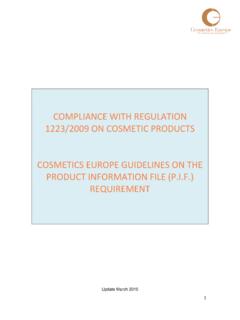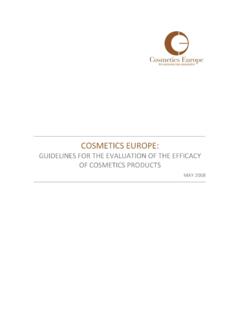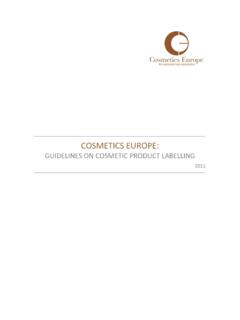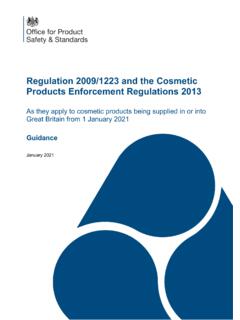Transcription of GUIDELINES FOR COSMETIC PRODUCT CLAIM …
1 GUIDELINES FOR COSMETIC PRODUCT CLAIM SUBSTANTIATION1 Table of Contents1. Regulatory and Self-Regulatory Aim of this document 2. COSMETIC PRODUCT The COSMETIC PRODUCT Claims: definition and scope 3. EVIDENCE SUPPORT: the building General requirements Consumer message, reasonable consumer expectations and supporting Generally accepted General principles for all Evaluation of PRODUCT and ingredient Post-marketing testimonials and endorsements Presentation of the evidence support 4. INFORMATION WHICH SHOULD APPEAR ON ALL TEST General Study protocol5. INFORMATION WHICH SHOULD APPEAR ON ALL TEST General Specific informationANNEXES:1.
2 Statistical guidance 2. Reference documents3. Reference documents regarding national specificitiesGUIDELINES FOR COSMETIC PRODUCT CLAIM SUBSTANTIATIONR evising and expanding the Colipa GUIDELINES on Efficacy (2001/rev. 2008)22 May FOR COSMETIC PRODUCT CLAIM INTRODUCTION Regulatory and self-regulatory backgroundCCosmetic PRODUCT claims are essential tools for differentiating between products, stimulating innovation and fostering competition. To fulfil this role, claims must be able to evolve with national markets, scientific progress and the diversity of consumers, as well as with changes in societal demands, trends and fashions.
3 COSMETIC PRODUCT claims are subject to a framework of regulation and self-regulation that is comprehensive and ensures a high level of consumer protection1 from misleading claims. This framework combines horizontal ( applying to all advertising and commercial practices) and COSMETIC -specific legislation with self-regulation. This is illustrated in the figure below:It is acknowledged that claims must be assessed case-by-case and that a flexible approach should be taken towards communicating the messages to end users so as to take into account the social, linguistic and cultural diversity of the european Union and to preserve the innovation and the competitiveness of european industry.
4 Such an approach is consistent with the principles enunciated by the Court of Justice, which has pointed out on several occasions that in order to determine whether a CLAIM is capable of misleading the consumer it is necessary to consider the latter s expectations, taking account of the specific context and circumstances in which the CLAIM is made, including social, cultural and linguistic all Member States, COSMETIC PRODUCT claims are controlled by appointed control authorities; in addition, in many Member States COSMETIC PRODUCT claims used in advertising are controlled by self-regulatory bodies. In some Member States, control of claims is largely achieved through court action3.
5 ALL CLAIMS AND ADVERTISINGSelf-regulation (International Chamber of Commerce Code, National Codes)Illustration of the regulatory and self-regulatory landscape for COSMETIC PRODUCT claims and advertisingEC GUIDELINESB-2-CThe Unfair Commercial Practices Directive (UCPD)B-2-BThe Misleading and Comparative Advertising Directive (MCAD)B-2-C and B-2-B The Cosmetics PRODUCT Regulation (CPR), Article 20, and the Common Criteria RegulationCosmetics Europe Charter & Guiding PrinciplesEC Guidance (Technical Document)National Competent AuthoritiesSelf Reg. PRODUCT claims (referring to PRODUCT charcteristics and/or functions)1. As confirmed by the european Commission in its Report on PRODUCT claims made based on common criteria in the field of cosmetics, COM (2016) 580 final, See Case C-220/98, Est e Lauder Cosmetics vs.
6 Lancaster [2000], ECR I-00117, paragraph For example, the specific enforcement system against unfair commercial practices in Germany is explained under GUIDELINES FOR COSMETIC PRODUCT CLAIM all claims made in relation to the marketing of COSMETIC products are covered by Article 20 of the COSMETIC Products Regulation4 (CPR). For example, claims that are not related to the PRODUCT s characteristics and functions ( claims related to packaging or to pricing) are covered by other regulatory frameworks. These include, in particular, the Unfair Commercial Practices Directive (UCPD), and the Misleading and Comparative Advertising Directive (MCAD).
7 Accordingly, for the purposes of this document, the term COSMETIC PRODUCT claims only refers to those claims falling under the scope of Article 20 of the Regulatory requirementsArticle 20 of the CPR requires claims not to be used to imply that COSMETIC products (as defined under Article of the CPR) have characteristics and functions which they do not ensure that COSMETIC PRODUCT claims are not misleading, the benefits provided by the PRODUCT must correspond to the reasonable expectation(s) of consumers, as created by the claims. The assessment of claims acceptability must be based on the perception of the average end-user of a COSMETIC PRODUCT , who is reasonably well-informed and reasonably observant and circumspect, taking into account social, cultural and linguistic factors on the market in justified by the nature or the effect of the COSMETIC PRODUCT , in accordance with Article of the CPR, the proof of the effect claimed must be documented in the PRODUCT Information File (PIF).
8 In other words, the effect claimed must be substantiated and the evidence must be recorded and referenced in the PIF. Responsible Persons are responsible for the evidence provided for the claims they make; these claims must be consistent with the nature and the scope of such evidence. Guiding principles regarding the level of detail are provided in section Presentation of the Evidence PRODUCT claims must comply with the legally-binding Common Criteria Regulation5 which lays down six criteria that must be met for the justification of claims used in relation to COSMETIC products: legal compliance; truthfulness; evidential support; honesty; fairness; informed PRODUCT claims compliance with the relevant horizontal legislation (mainly the Unfair Commercial Practices Directive6 and the Misleading and Comparative Advertising Directive7) is also required.
9 Official technical documents and guidance notes are useful to help the interpretation of the legal requirements. The Cosmetics Unit of the european Commission s Directorate General Internal Market, Industry, Entrepreneurship and SMEs (DG GROW) has issued a Technical Document on COSMETIC PRODUCT Claims8 which provides non-binding guidance for the case-by-case application of the Common Criteria. In a Communication to its membership, issued on 5 October 2017, Cosmetics Europe strongly advised its members to follow the guidance therein since it is a reference for national competent and control authorities and may be used in their market surveillance Self-regulationSelf-regulatory systems ( the codes of the International Chamber of Commerce and national codes) help industry provide an additional level of consumer protection by building consumer trust in brands through the promotion of responsible advertising.
10 In 2012, Cosmetics Europe developed its Charter and Guiding Principles on Responsible Advertising and Marketing Communications (C&GP), demonstrating a voluntary and proactive commitment to the responsible advertising of COSMETIC products in the EU. The C&GP has been adopted by all national association members of Cosmetics Europe and is being gradually implemented in the national advertising codes, to the extent Aim of this documentThe objective of this document is to provide guidance for cosmetics companies regarding the substantiation of their PRODUCT claims. The document addresses CLAIM substantiation from a european perspective but more specific requirements, GUIDELINES or case law may exist at national level in the EU Member States and, where this is the case, these should take precedence over this guidance.








